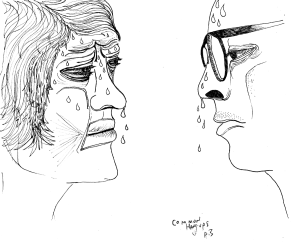
(excerpt from Learn to Freestyle with FFG)
There’s lots of hangups and handicaps that can prevent someone from reaching their freestyle potential. This is a list of some common ones with some helpful exercises that you will find later in the book.
Mic Shy: some people are afraid to say anything on the mic, sometimes not even their name. Don’t “over-encourage” them, this will make them even more mic shy. Different tactics work with different people: gentle encouragement, forceful insistence, faux-mockery, pleading, gentle-bribery and breakout sessions (with no mic or a one-on-one) can be successful methods. Also, try just letting them be and making sure to keep checking in with them. Keep the topics light so the barrier is low and they know they don’t need to be “cool” or stick to typical topics. Exercises that help include “What’s My Name?” (p74), and “Repeat After Me” (p77).
Nothing to Say: Some people are comfortable on the mic but experience content block so they “have nothing to say.” They can be offered topics to help them out, or encouraged to scat — vocalizing with no words at all. You can also engage them with a partner in a freestyle dialogue, asking them questions they can answer on the mic, perhaps about what they ate or what they did that day. Good exercises include “Points” and “Repeat After Me,” “Rapscat,” “Freestyle Standards,” “Talking points,” “Freestyle Alphabet,” “Freestyle Games.”
Rhythmically Challenged: These folks will freestyle without adequate awareness of the beat and and rhythm, and focus too heavily on what they are saying rather than how they are saying it. All of us are to some degree guilty of this. The rhythmically challenged can be encouraged to listen to the beat and try to temporarily care less about what words (if any) they are saying. Work with simple, stripped down beats. Maybe even get them to rhyme with a metronome app — one word per tick. Then add two words per tick, then three, etc., varying placing words on the tick, and between ticks. Even better, get them to stop using words altogether and rap gibberish to the beat. Exercises: “Metronome”(p??) and “Rapscat”(p??).
Bad projection: Some people are comfortable on the mic, they stay on beat and have lots to say — but don’t say it well. This can be due to poor mic technique, low voice volume, or weak articulation. They can be encouraged to pay attention to how they hold the mic: specifically, keep the mic pointed at the mouth from a consistent distance while maintaining steady vocal output. Be aware of the voice volume level, the distance, and the sound of their voice from the system are related. If the mic technique is good, then examine the vocal style and the vocal volume. Good exercises include “Mix up Style,” “Tone Up and Tone Downs,” “Whisper Style,” “Shout Style.”